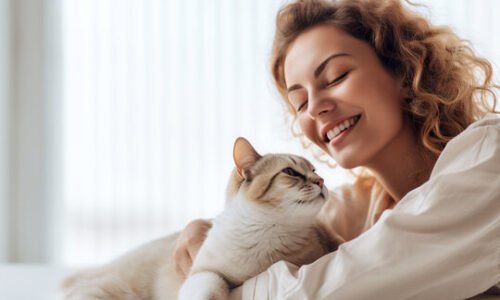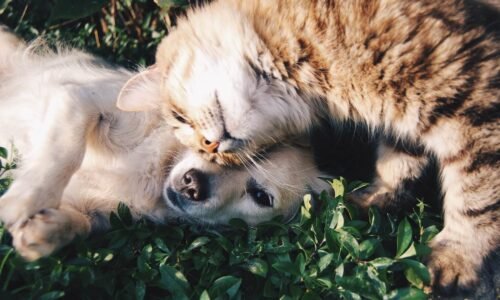Cats are fascinating and mysterious creatures with their own unique ways of communicating. Unlike dogs, who are often more straightforward in their expressions, cats use a combination of vocalizations, body language, and subtle cues to convey their feelings and needs. Learning to decipher your cat’s language can strengthen your bond and help you understand what your feline friend is trying to tell you. Here’s a guide to some common cat behaviors and what they might mean.
1. Meowing: The Many Voices of Your Cat
Cats meow for various reasons, and each type of meow can have a different meaning:
- Short Meows: These are often greetings or requests for attention. Your cat might be saying, “Hello!” or asking for some affection.
- Chirps and Trills: These sounds are often used by cats to communicate with their kittens, but adult cats may use them to get your attention or as a friendly greeting.
- Loud, Repeated Meows: If your cat is meowing loudly and persistently, it could mean they’re hungry, bored, or want something specific. Pay attention to when and where they meow this way to better understand their needs.
- Low-Pitched Meows or Growls: These are usually signs of discomfort, annoyance, or aggression. It’s your cat’s way of saying they’re unhappy or warning you to back off.
2. Purring: Not Always a Sign of Happiness
Purring is one of the most common sounds cats make, and while it often indicates contentment, it can also mean other things:
- Contentment: A cat curled up in your lap and purring softly is likely feeling happy and relaxed.
- Seeking Comfort: Cats sometimes purr when they’re anxious, sick, or in pain as a way to self-soothe.
- Attention-Seeking: Cats may purr to get your attention, especially if they associate purring with receiving affection, food, or care.
3. Tail Talk: Understanding Your Cat’s Mood
A cat’s tail can be one of the clearest indicators of their mood:
- Upright Tail: When your cat’s tail is upright and slightly curved, they’re usually feeling confident, friendly, and happy to see you.
- Puffed-Up Tail: A fluffed-up tail signals fear or aggression. Your cat may feel threatened and is trying to make themselves look bigger.
- Tail Twitching: A rapidly twitching or swishing tail may indicate irritation or agitation. Your cat might be feeling playful, annoyed, or overstimulated.
- Tucked Tail: If your cat’s tail is tucked between their legs, it’s a sign of fear or submission. Approach your cat gently and calmly if you notice this behavior.
4. Ear Positions: What Your Cat’s Ears Are Telling You
Your cat’s ears can also give you valuable insights into their feelings:
- Ears Facing Forward: When your cat’s ears are pointed forward, they’re alert and interested in their surroundings. This is often a sign of curiosity or playfulness.
- Ears Turned Sideways or Back: Cats often turn their ears sideways or flatten them against their head when they’re feeling threatened, anxious, or annoyed.
- Swiveling Ears: If your cat’s ears are moving back and forth, they’re likely listening intently to different sounds. They may be on high alert, assessing the situation around them.
5. Slow Blinking: The “Cat Kiss”
If your cat gives you a slow blink, consider it a sign of affection and trust. Cats use slow blinking as a way to communicate that they feel safe and relaxed around you. You can return the gesture by slowly blinking back to show your cat that you feel the same way.
6. Kneading: A Comforting Behavior
Kneading, where cats press their paws into a soft surface (like a blanket or your lap), is a behavior they often carry from kittenhood. It’s a comforting and soothing action that can indicate your cat feels safe and content. Cats may also knead when they’re feeling affectionate, so if your cat kneads on you, consider it a sign of love.
7. Head Butting or Bunting: A Sign of Affection
When your cat rubs their head or face against you, it’s a way of marking you with their scent. Cats have scent glands on their cheeks, and they use head butting, also known as bunting, to show affection and mark their territory. It’s your cat’s way of saying, “You’re part of my family.”
8. Licking: Grooming as a Bonding Experience
Cats groom themselves to stay clean, but when they groom you, it’s a sign of affection and trust. It’s their way of showing that they feel bonded to you, similar to how they would groom another cat. However, excessive licking can also be a sign of stress, so it’s important to observe the context and frequency of the behavior.
9. Hiding: A Sign of Stress or Fear
If your cat is hiding more than usual, it may indicate they’re feeling stressed, afraid, or unwell. Cats often retreat to safe spaces when they’re feeling overwhelmed or anxious. Providing them with a quiet, cozy space where they feel secure can help, but if the behavior persists, a visit to the vet might be necessary to rule out any health issues.
10. Arching Their Back: Interpreting the Stance
An arched back can mean different things depending on the context:
- Fear or Aggression: If your cat’s back is arched and their fur is standing up, they’re likely scared or feeling threatened. This defensive posture is meant to make them appear larger.
- Playfulness: Sometimes cats arch their back in a playful manner, especially when they’re excited or engaged in a game. If your cat’s tail is upright and they’re making playful movements, they’re likely just having fun.
Conclusion
Understanding your cat’s language is all about observing their behavior and interpreting their cues. By paying attention to their vocalizations, body language, and subtle gestures, you can gain insight into their emotions and strengthen your bond. The more you learn to communicate with your cat, the more harmonious and fulfilling your relationship will be.



